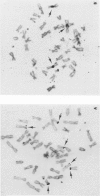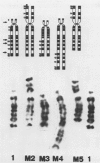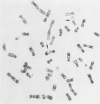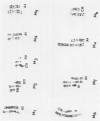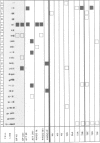Abstract
Chromosomal abnormalities are a frequent concomitant of neoplasia, and although it is tempting to relate these mutations and alterations in chromatin (DNA) function to cancer, their relationship to the initiation or progression of carcinogenesis is unknown. Mammalian cells in culture, after interacting with chemical carcinogens, often exhibit chromosome damage consisting of breaks and exchanges of chromatid material. The pattern of damage of banded metaphases indicates that negative bands are especially vulnerable to the action of chemical carcinogens, probably because of differential chromatin condensation. Damage to individual chromosomes may be random or nonrandom, depending on the species. Cell death can be correlated with chromatid alterations that occur shortly after treatment with chemical carcinogens. There is also a correlation between mutagenic and carcinogenic activity of some chemical carcinogens and the frequency of sister chromatid exchanges. The question of whether specific chromosome changes are absolutely required for neoplastic transformation cannot be answered because of conflicting data and diverse results from studies even with known carcinogens. Cell transformation may occur without any visible chromosome changes. A universal specific numerical or visible structural chromosomal alteration is not necessarily associated with chemical or viral transformation. Chromosome changes are independent of the etiologic agents: different carcinogens may produce transformation associated with the same abnormal chromosomes, but not all transformed lines invariably exhibit the same abnormality, even with the same chemical. In some species, chromosome having nucleolar organizer regions may be more frequently involved in numerical or structural deviations. Progressively growing tumors also may occur as a result of the proliferation of transformed cells without detectable chromosome changes, indicating that tumorigenicity need not be related to an imbalance of chromosome number or structure. Our studies indicate that chromosome changes are not essential for establishment of neoplasms but that karyotypic instability may result in response to selective growth pressures.
Full text
PDF

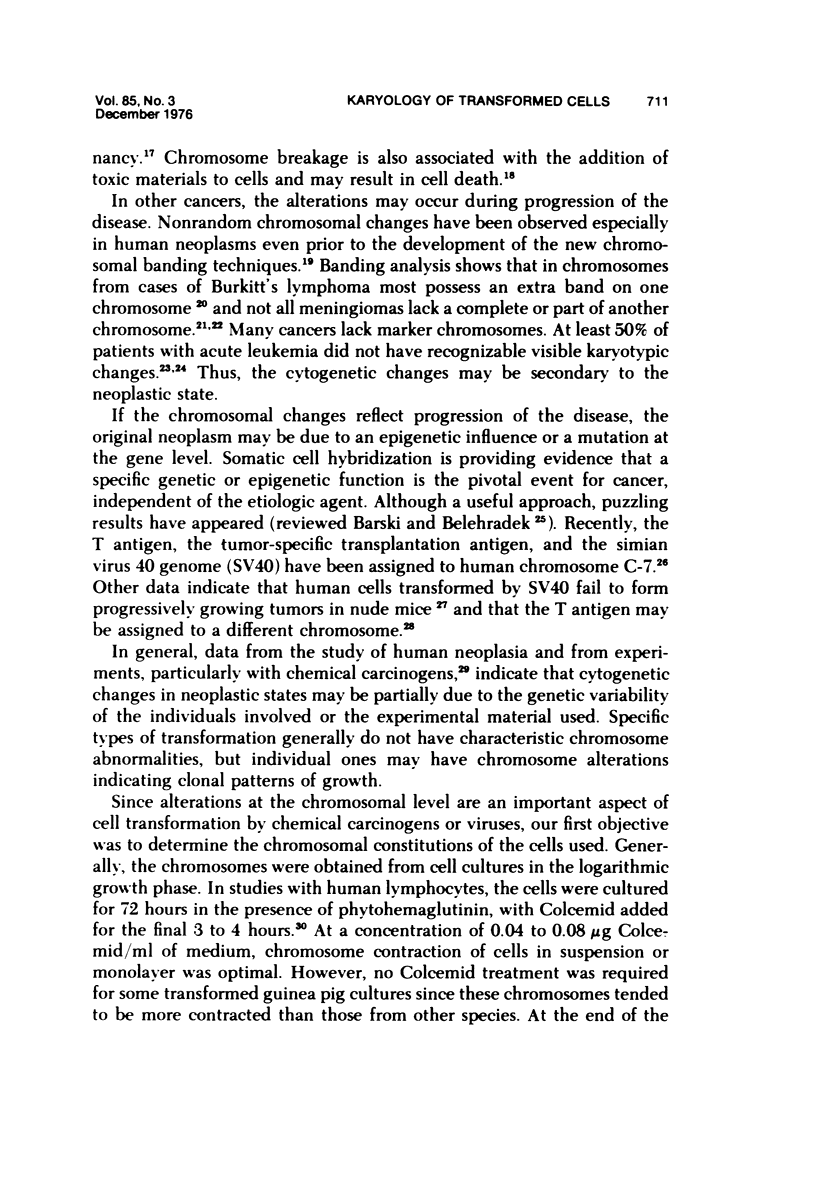


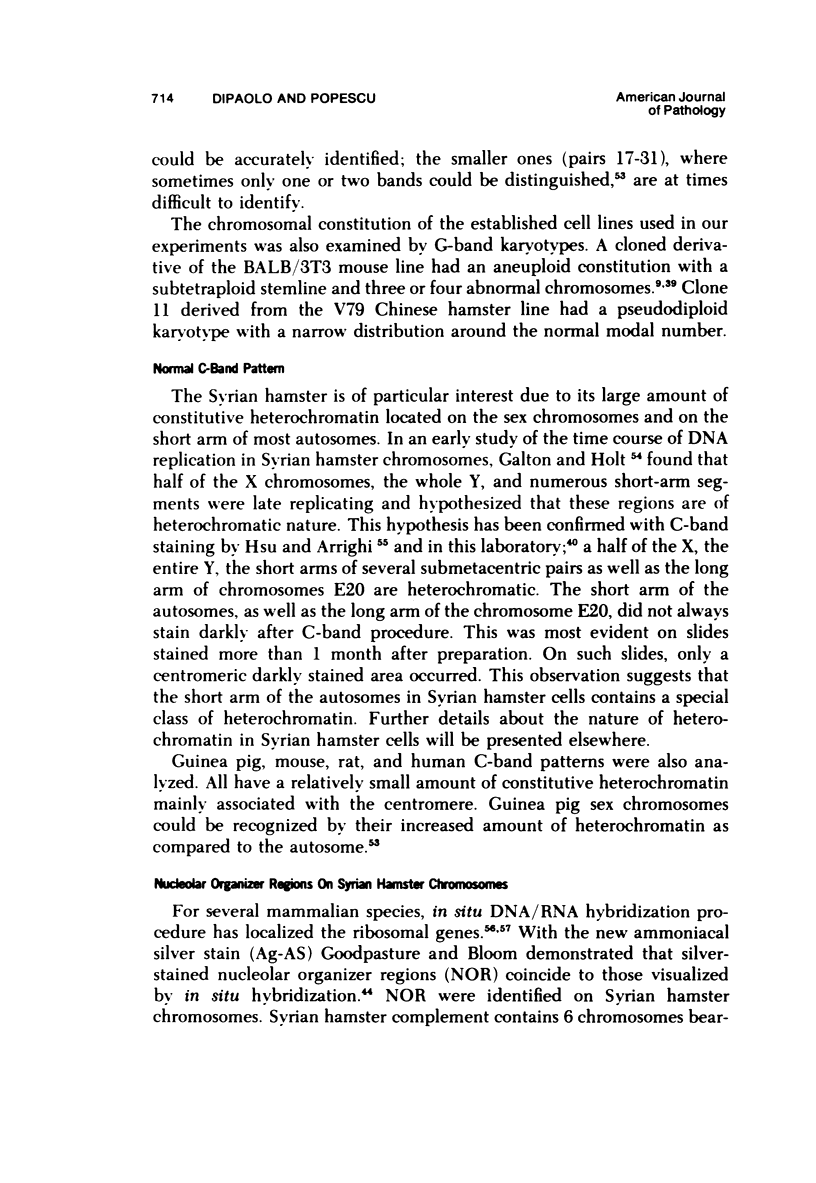
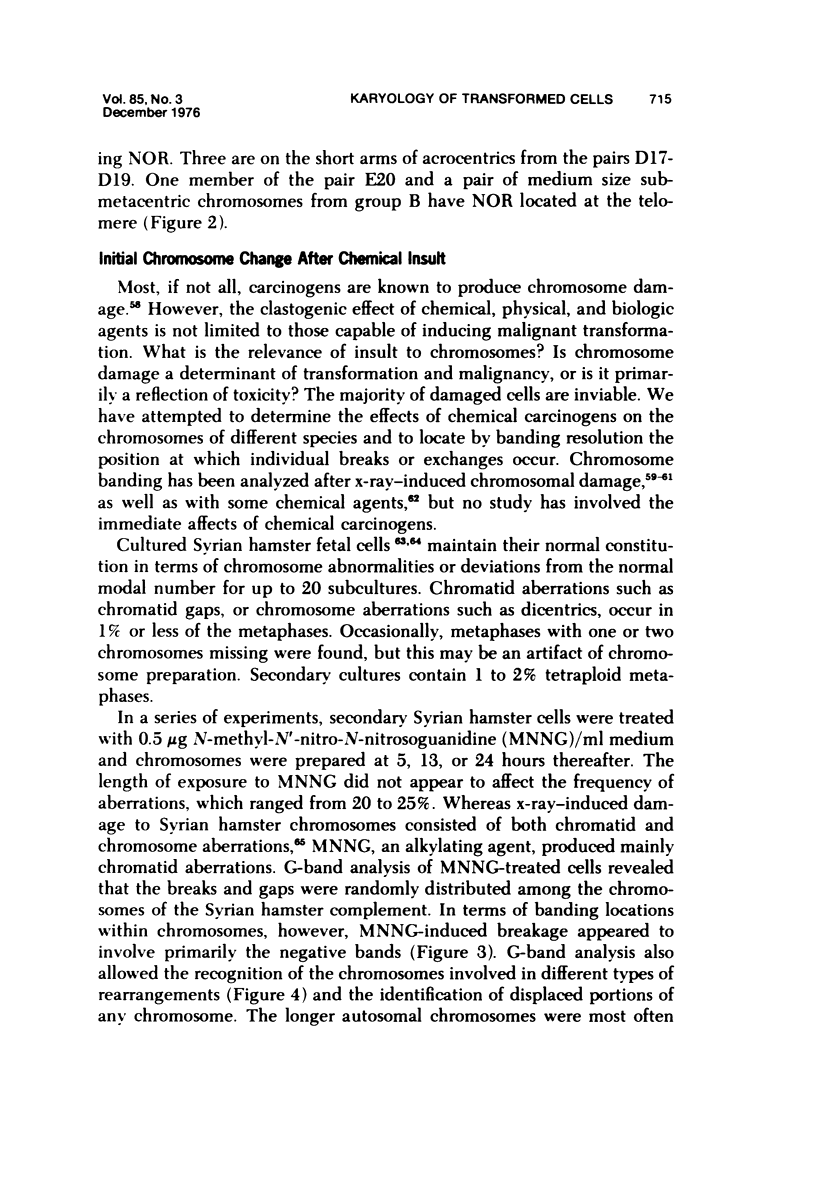
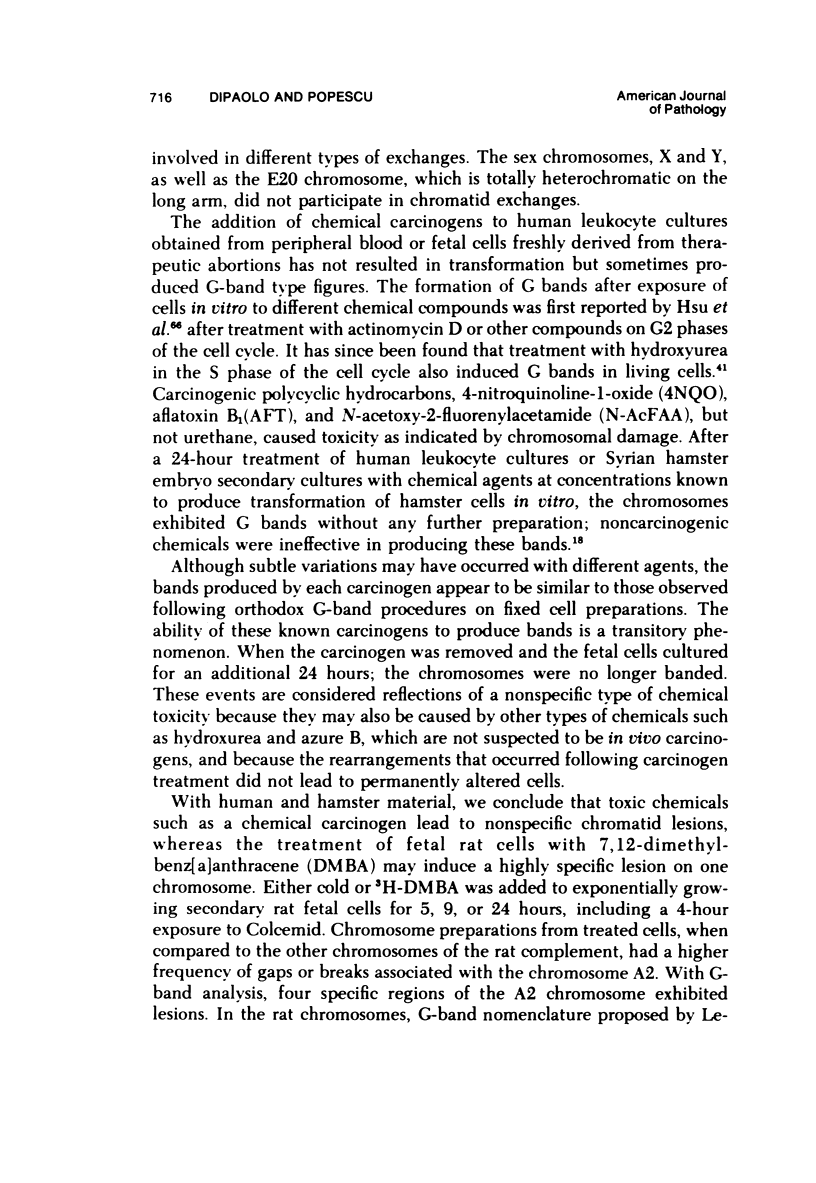
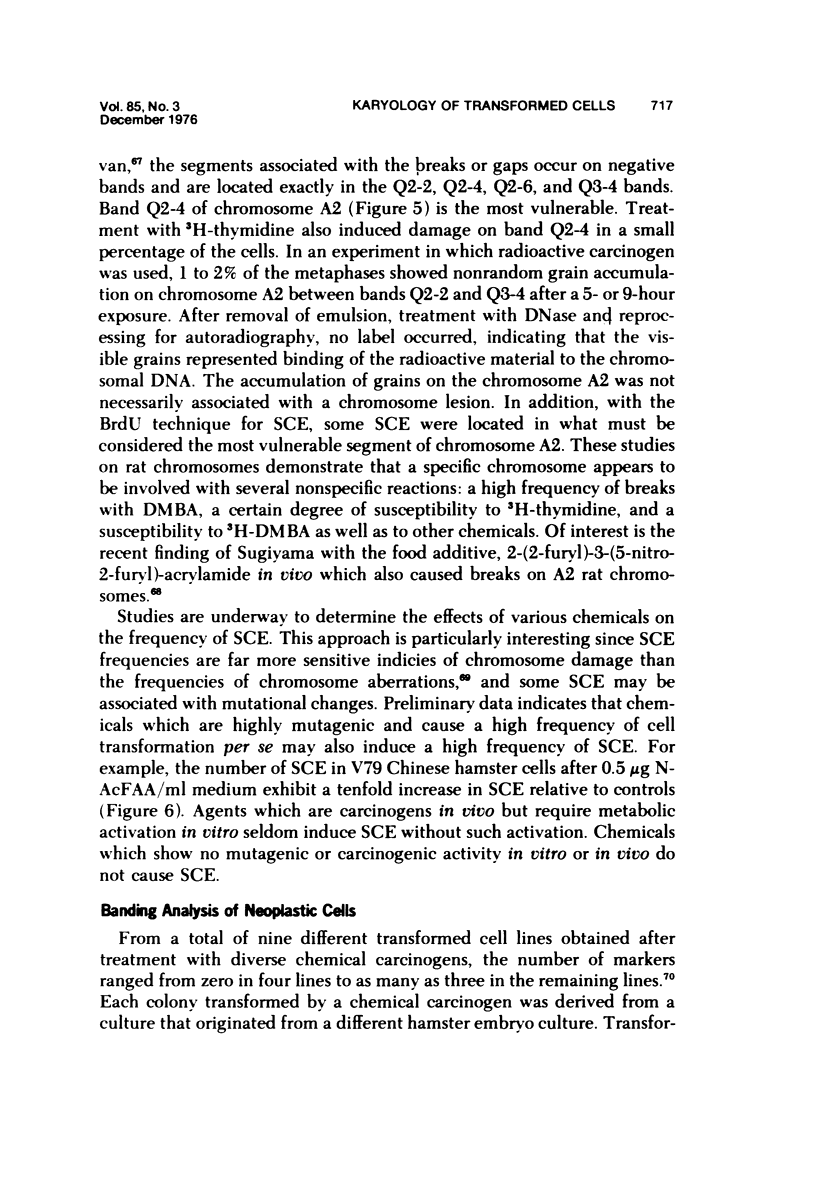
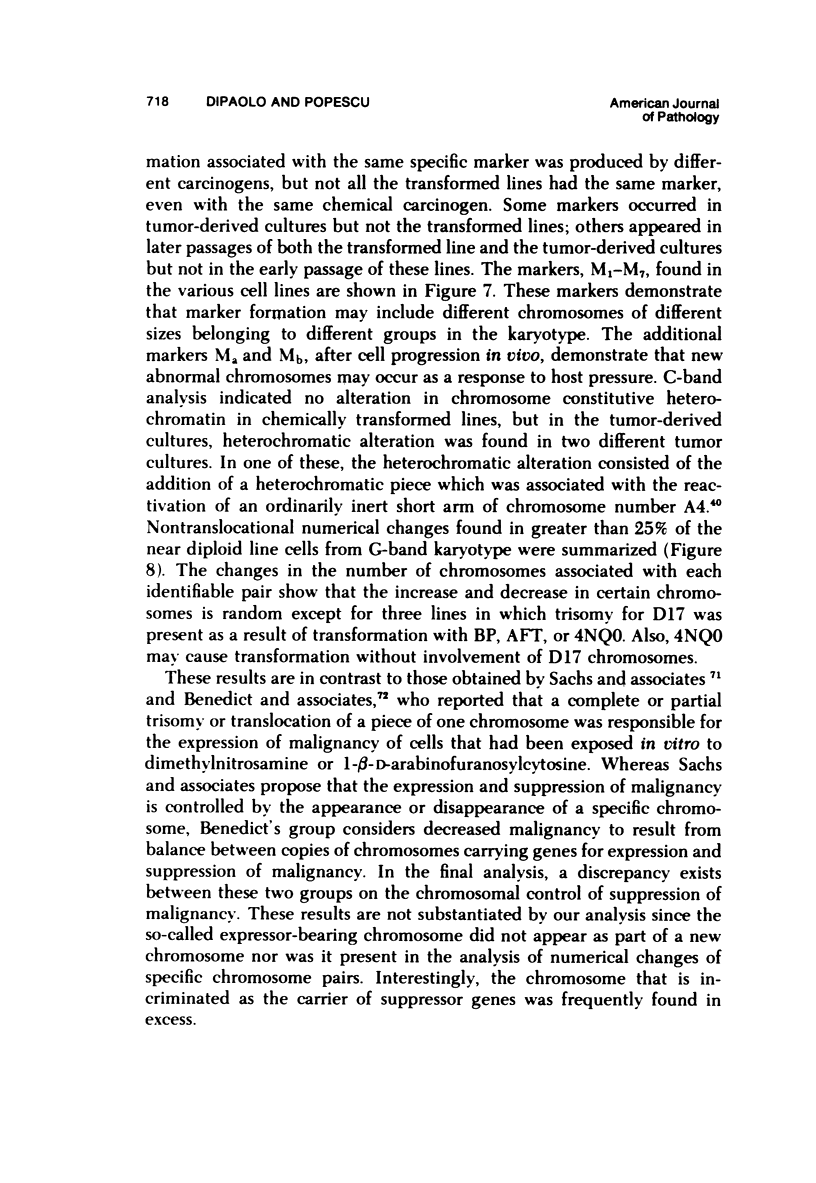


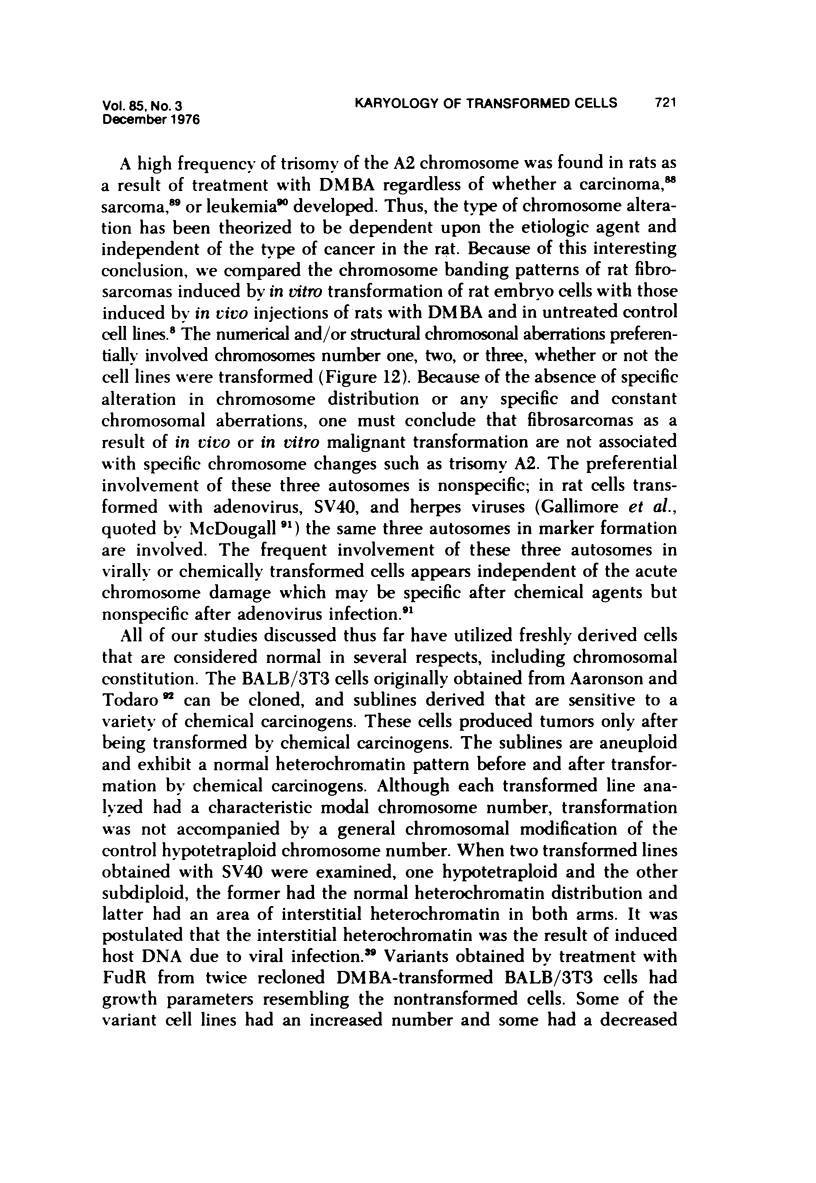
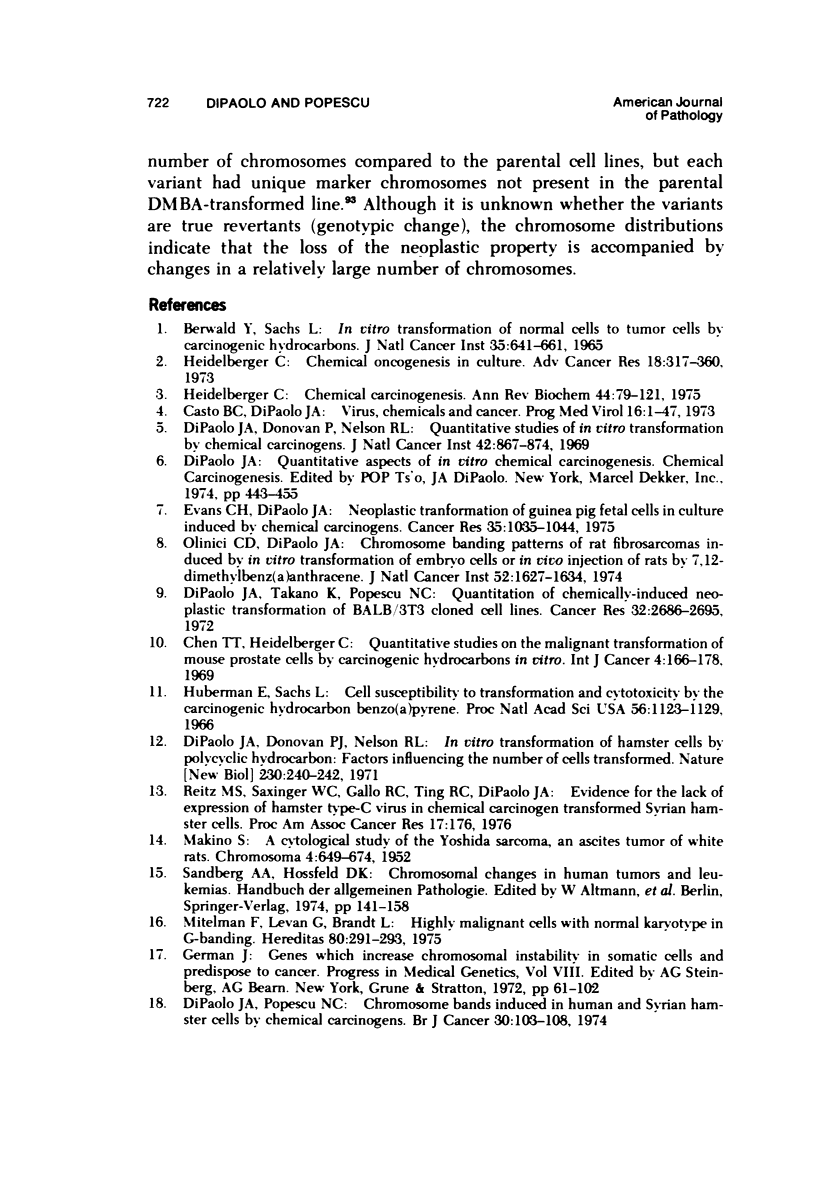
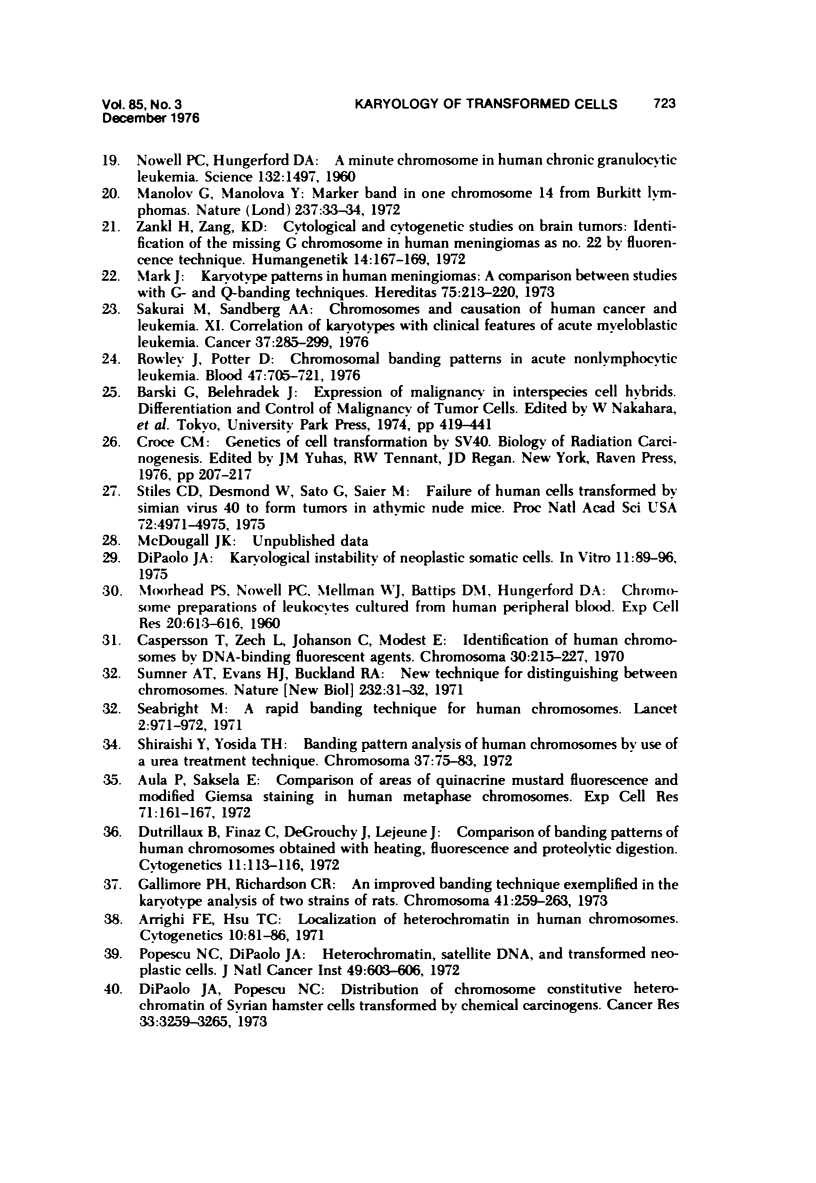
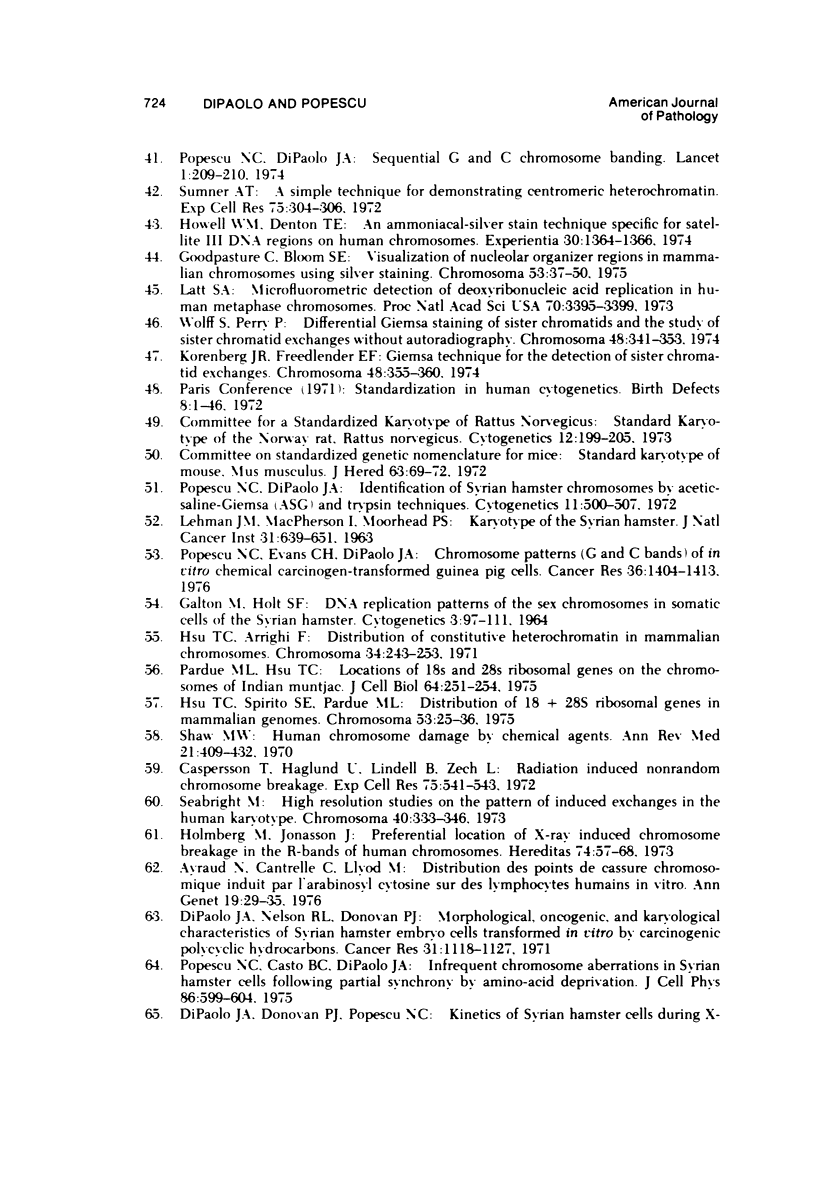

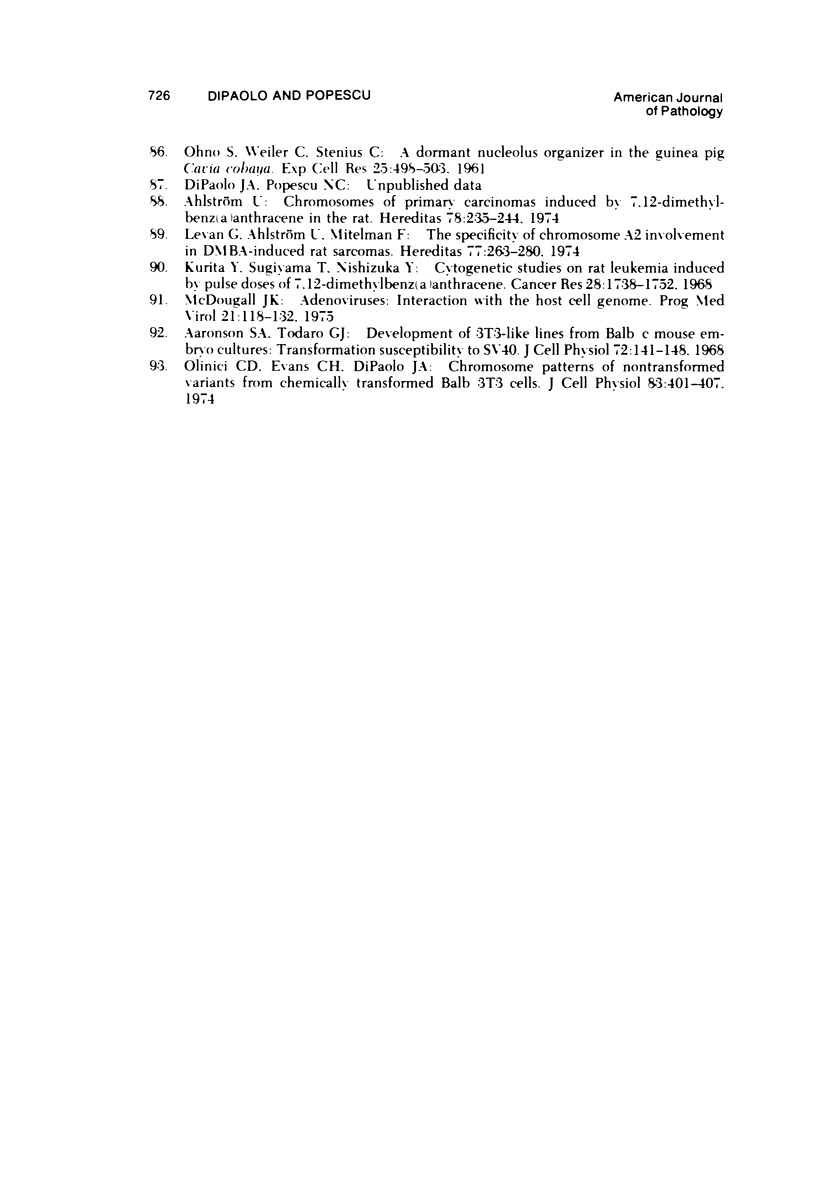
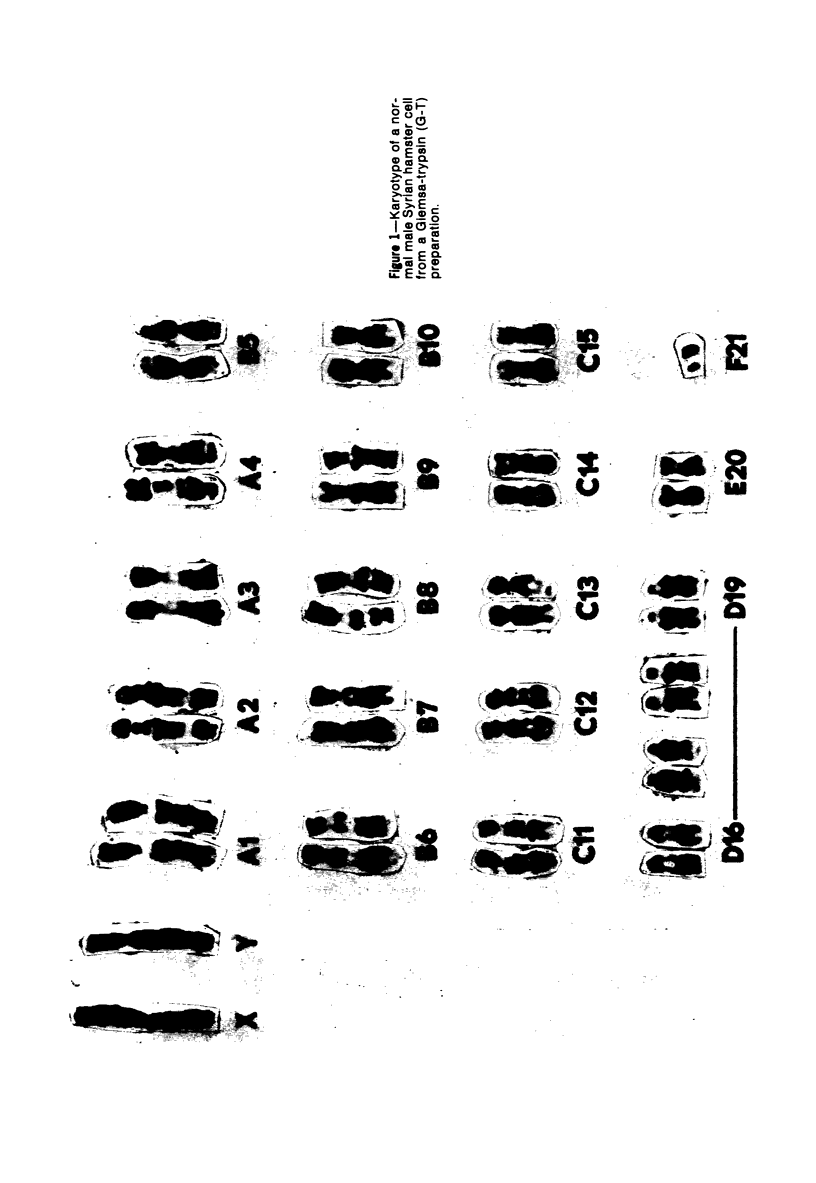

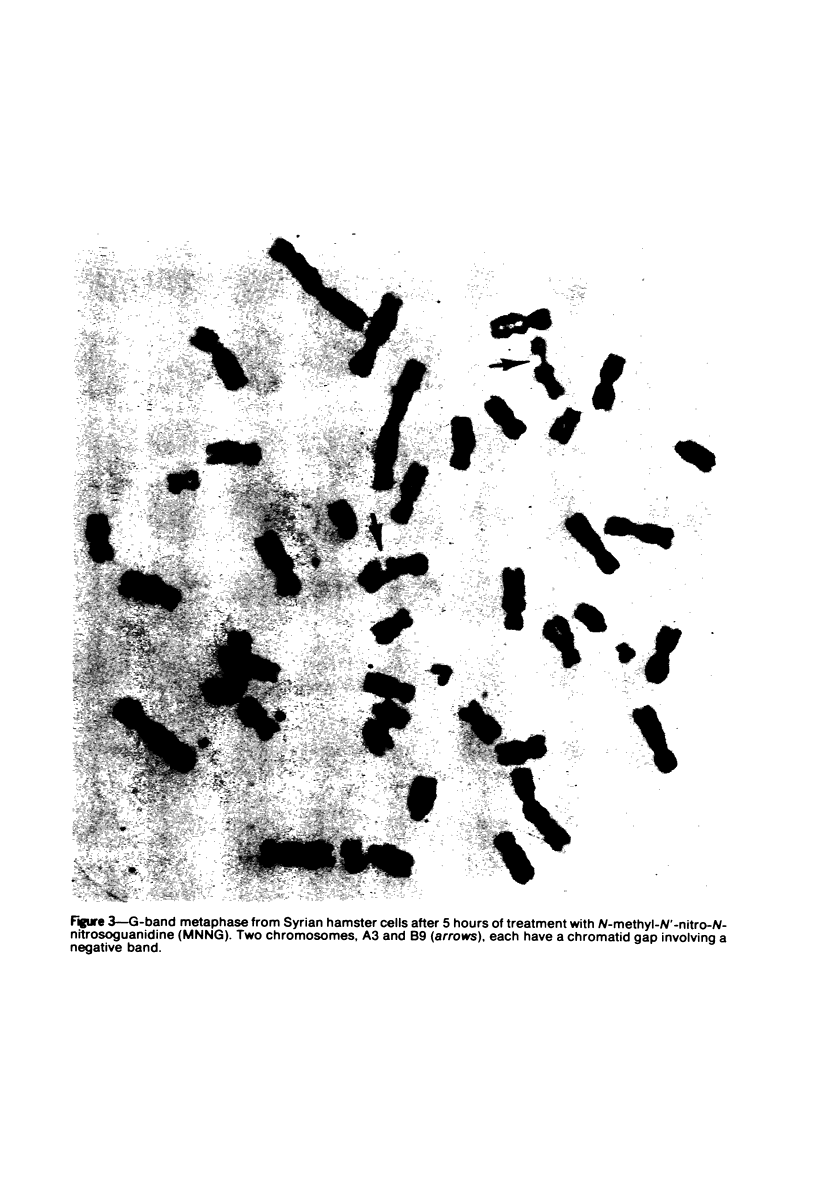





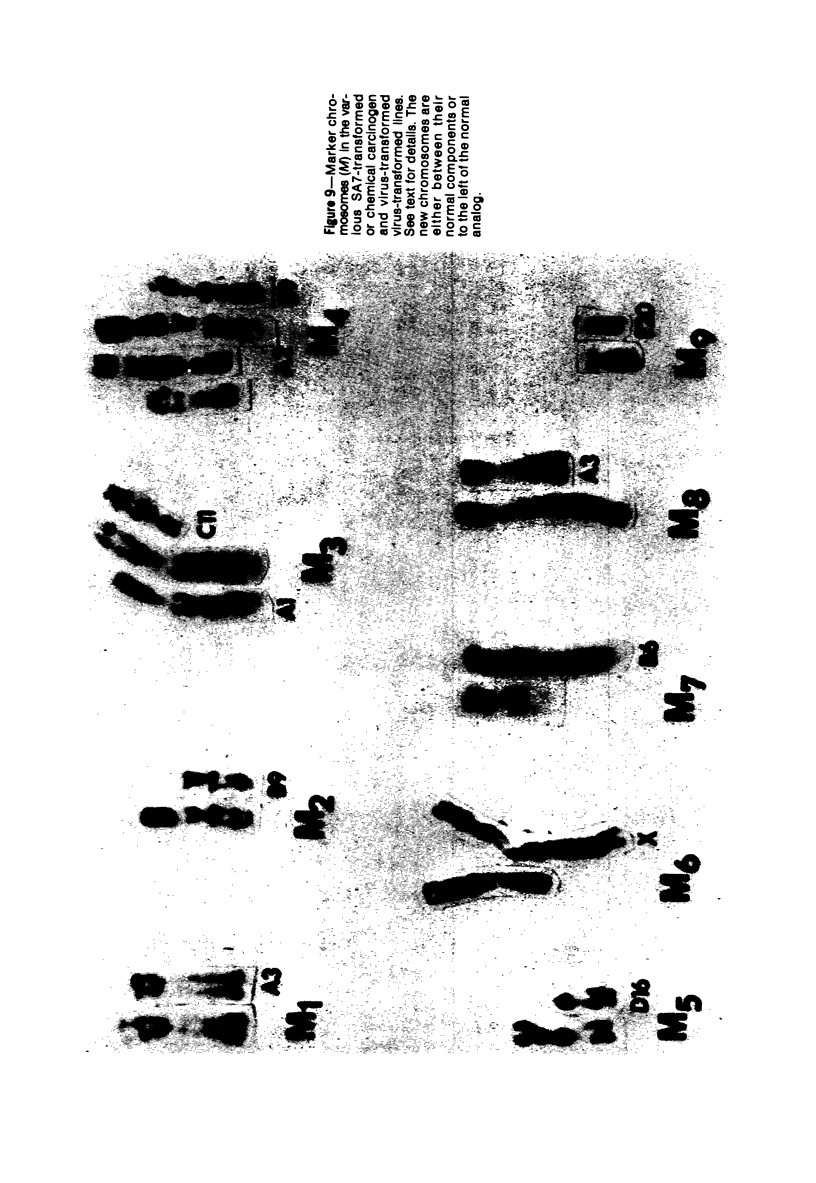
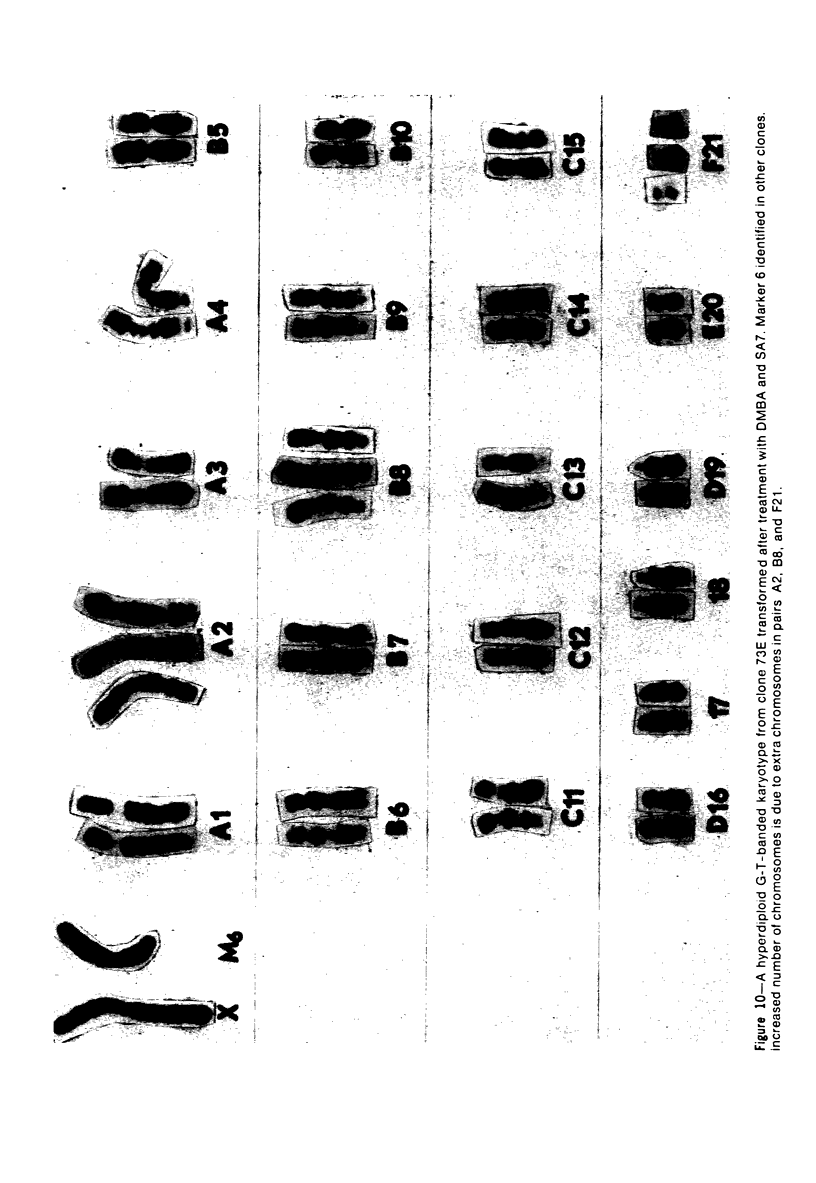
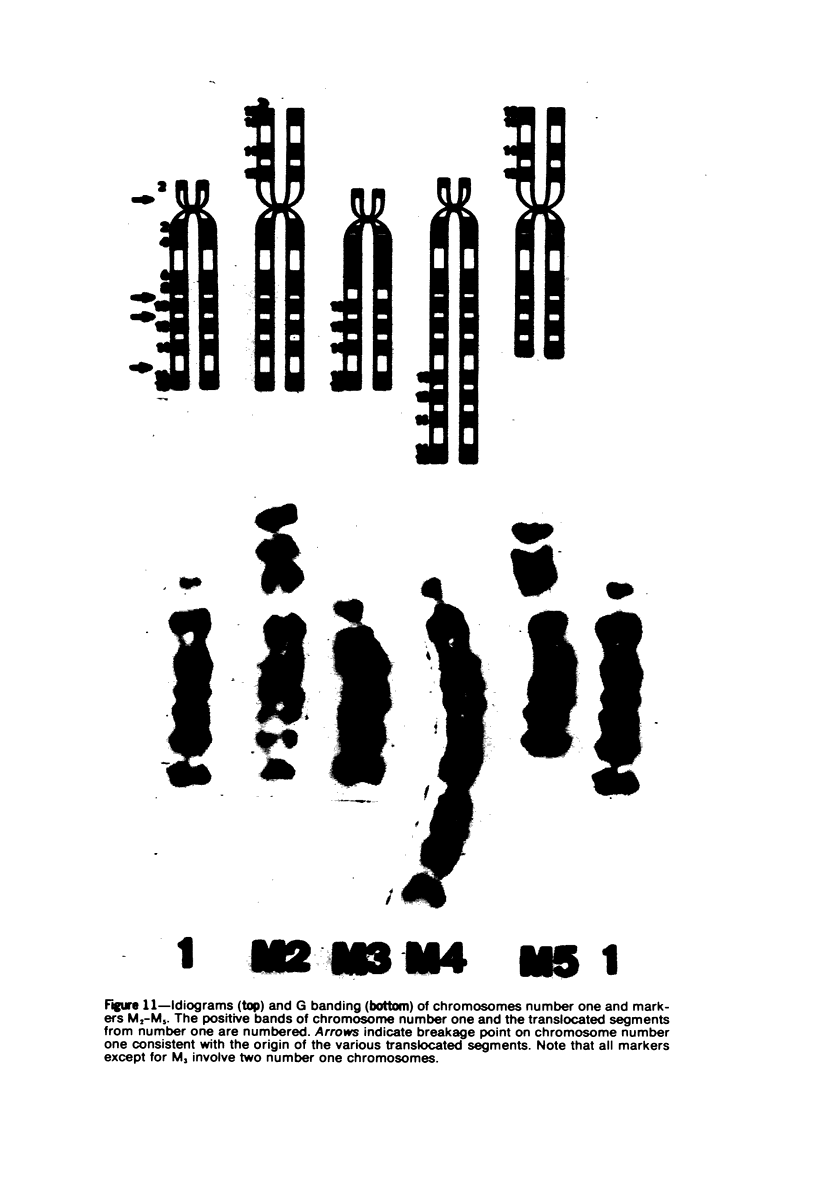
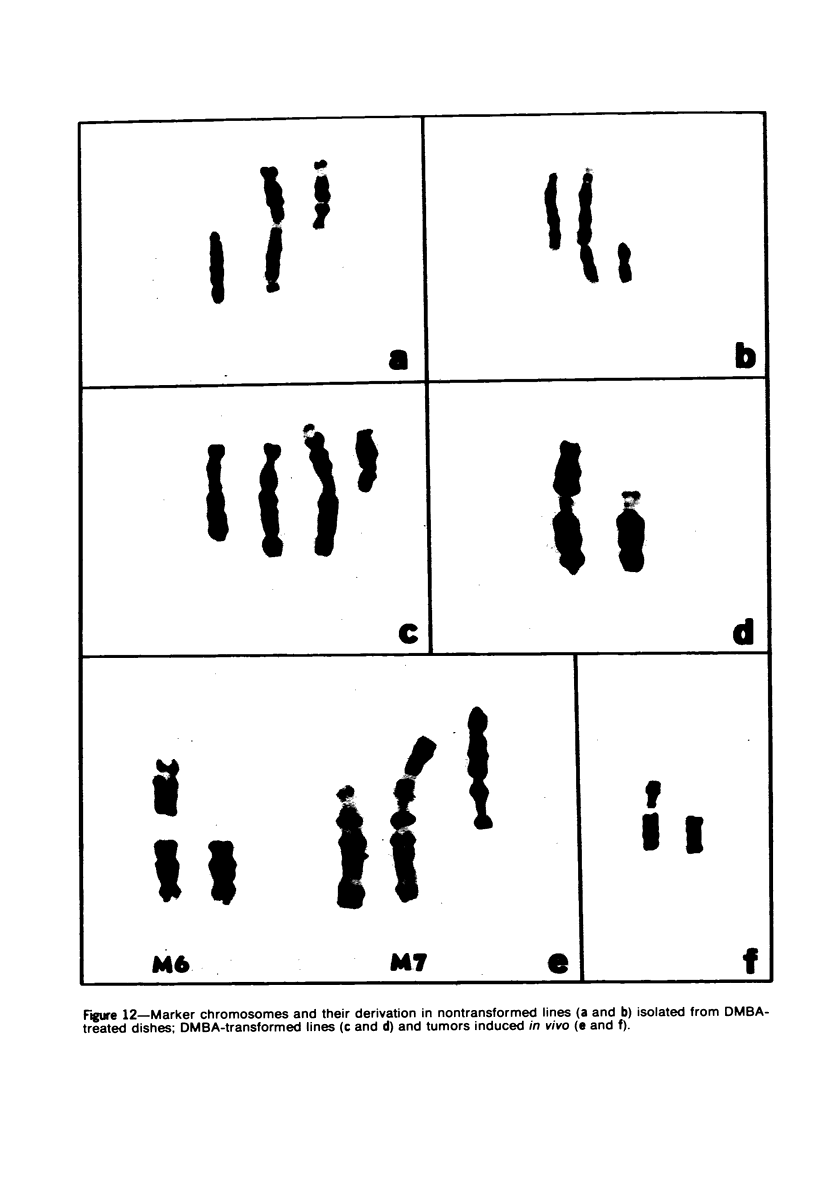
Images in this article
Selected References
These references are in PubMed. This may not be the complete list of references from this article.
- Aaronson S. A., Todaro G. J. Development of 3T3-like lines from Balb-c mouse embryo cultures: transformation susceptibility to SV40. J Cell Physiol. 1968 Oct;72(2):141–148. doi: 10.1002/jcp.1040720208. [DOI] [PubMed] [Google Scholar]
- Ahlstrom U. Chromosomes of primary carcinomas induced by 7,12-dimethylbenz(a)anthracene in the rat. Hereditas. 1974;78(2):235–244. doi: 10.1111/j.1601-5223.1974.tb01444.x. [DOI] [PubMed] [Google Scholar]
- Arrighi F. E., Hsu T. C. Localization of heterochromatin in human chromosomes. Cytogenetics. 1971;10(2):81–86. doi: 10.1159/000130130. [DOI] [PubMed] [Google Scholar]
- Aula P., Saksela E. Comparison of areas of quinacrine mustard fluorescence and modified Giemsa staining in human metaphase chromosomes. Exp Cell Res. 1972 Mar;71(1):161–167. doi: 10.1016/0014-4827(72)90274-1. [DOI] [PubMed] [Google Scholar]
- Ayraud N., Cantrelle C., Lloyd M. Distribution des points de cassure chromosomique induits par l'arabinosyl cytosine sur des lymphocytes humains in vitro. Ann Genet. 1976 Mar;19(1):29–35. [PubMed] [Google Scholar]
- BARSKI G., CORNEFERT F. CARACT'ERISTIQUES CARYOLOGIQUES DES TUMEURS PULMONAIRES DE HAMSTERS PRODUITES PAR L'AD'ENOVIRUS 12. Ann Inst Pasteur (Paris) 1964 Jul;107:114–120. [PubMed] [Google Scholar]
- Benedict W. F., Rucker N., Mark C., Kouri R. E. Correlation between balance of specific chromosomes and expression of malignancy in hamster cells. J Natl Cancer Inst. 1975 Jan;54(1):157–162. doi: 10.1093/jnci/54.1.157. [DOI] [PubMed] [Google Scholar]
- Berwald Y., Sachs L. In vitro transformation of normal cells to tumor cells by carcinogenic hydrocarbons. J Natl Cancer Inst. 1965 Oct;35(4):641–661. [PubMed] [Google Scholar]
- Caspersson T., Zech L., Johansson C., Modest E. J. Identification of human chromosomes by DNA-binding fluorescent agents. Chromosoma. 1970;30(2):215–227. doi: 10.1007/BF00282002. [DOI] [PubMed] [Google Scholar]
- Casto B. C., DiPaolo J. A. Virus, chemicals and cancer. Prog Med Virol. 1973;16:1–47. [PubMed] [Google Scholar]
- Casto B. C., Pieczynski W. J., DiPaolo J. A. Enhancement of adenovirus transformation by treatment of hamster embryo cells with diverse chemical carcinogens. Cancer Res. 1974 Jan;34(1):72–78. [PubMed] [Google Scholar]
- Chen T. T., Heidelberger C. Quantitative studies on the malignant transformation of mouse prostate cells by carcinogenic hydrocarbons in vitro. Int J Cancer. 1969 Mar 15;4(2):166–178. doi: 10.1002/ijc.2910040207. [DOI] [PubMed] [Google Scholar]
- DiPaolo J. A., Donovan P. J., Nelson R. L. In vitro transformation of hamster cells by polycyclic hydrocarbons: factors influencing the number of cells transformed. Nat New Biol. 1971 Apr 21;230(16):240–242. doi: 10.1038/newbio230240a0. [DOI] [PubMed] [Google Scholar]
- DiPaolo J. A., Donovan P., Nelson R. Quantitative studies of in vitro transformation by chemical carcinogens. J Natl Cancer Inst. 1969 May;42(5):867–874. [PubMed] [Google Scholar]
- DiPaolo J. A. Karyological instability of neoplastic somatic cells. In Vitro. 1975 Mar-Apr;11(2):89–96. doi: 10.1007/BF02624081. [DOI] [PubMed] [Google Scholar]
- DiPaolo J. A., Nelson R. L., Donovan P. J. Morphological, oncogenic, and karyological characteristics of Syrian hamster embryo cells transformed in vitro by carcinogenic polycyclic hydrocarbons. Cancer Res. 1971 Aug;31(8):1118–1127. [PubMed] [Google Scholar]
- DiPaolo J. A., Popescu N. C. Chromosome bands induced in human and Syrian hamster cells by chemical carcinogens. Br J Cancer. 1974 Aug;30(2):103–108. doi: 10.1038/bjc.1974.120. [DOI] [PMC free article] [PubMed] [Google Scholar]
- DiPaolo J. A., Popescu N. C. Distribution of chromosome constitutive heterochromatin of Syrian hamster cells transformed by chemical carcinogens. Cancer Res. 1973 Dec;33(12):3259–3264. [PubMed] [Google Scholar]
- DiPaolo J. A., Popescu N. C., Nelson R. L. Chromosomal banding patterns and in vitro transformation of Syrian hamster cells. Cancer Res. 1973 Dec;33(12):3250–3258. [PubMed] [Google Scholar]
- DiPaolo J. A., Takano K., Popescu N. C. Quantitation of chemically induced neoplastic transformation of BALB-3T3 cloned cell lines. Cancer Res. 1972 Dec;32(12):2686–2695. [PubMed] [Google Scholar]
- Dunn A. R., Gallimore P. H., Jones K. W., McDougall J. K. In situ hybridization of adenovirus RNA and DNA. II. Detection of adenovirus-specific DNA in transformed and tumour cells. Int J Cancer. 1973 May;11(3):628–636. doi: 10.1002/ijc.2910110314. [DOI] [PubMed] [Google Scholar]
- Dutrillaux B., Finaz C., de Grouchy J., Lejeune J. Comparison of banding patterns of human chromosomes obtained with heating, fluorescence, and proteolytic digestion. Cytogenetics. 1972;11(2):113–116. doi: 10.1159/000130181. [DOI] [PubMed] [Google Scholar]
- Evans C. H., DiPaolo J. A. Neoplastic transformation of guinea pig fetal cells in culture induced by chemical carcinogens. Cancer Res. 1975 Apr;35(4):1035–1044. [PubMed] [Google Scholar]
- Gallimore P. H., Richardson C. R. An improved banding technique exemplified in the karyotype analysis of two strains of rat. Chromosoma. 1973;41(3):259–263. doi: 10.1007/BF00344020. [DOI] [PubMed] [Google Scholar]
- Heidelberger C. Chemical carcinogenesis. Annu Rev Biochem. 1975;44:79–121. doi: 10.1146/annurev.bi.44.070175.000455. [DOI] [PubMed] [Google Scholar]
- Heidelberger C. Chemical oncogenesis in culture. Adv Cancer Res. 1973;18:317–366. doi: 10.1016/s0065-230x(08)60756-3. [DOI] [PubMed] [Google Scholar]
- Hsu T. C., Arrighi F. E. Distribution of constitutive heterochromatin in mamallian chromosomes. Chromosoma. 1971;34(3):243–253. doi: 10.1007/BF00286150. [DOI] [PubMed] [Google Scholar]
- Huberman E., Sachs L. Cell susceptibility to transformation and cytotoxicity by the carcinogenic hydrocarbon benzo[a]pyrene. Proc Natl Acad Sci U S A. 1966 Oct;56(4):1123–1129. doi: 10.1073/pnas.56.4.1123. [DOI] [PMC free article] [PubMed] [Google Scholar]
- Korenberg J. R., Freedlender E. F. Giemsa technique for the detection of sister chromatid exchanges. Chromosoma. 1974;48(4):355–360. doi: 10.1007/BF00290992. [DOI] [PubMed] [Google Scholar]
- Kurita Y., Sugiyama T., Nishizuka Y. Cytogenetic studies on rat leukemia induced by pulse doses of 7,12-dimethylbenz(alpha)anthracene. Cancer Res. 1968 Sep;28(9):1738–1752. [PubMed] [Google Scholar]
- Latt S. A. Microfluorometric detection of deoxyribonucleic acid replication in human metaphase chromosomes. Proc Natl Acad Sci U S A. 1973 Dec;70(12):3395–3399. doi: 10.1073/pnas.70.12.3395. [DOI] [PMC free article] [PubMed] [Google Scholar]
- Levan G., Ahlström U., Mitelman F. The specificity of chromosome A2 involvement in DMBA-induced rat sarcomas. Hereditas. 1974;77(2):263–280. doi: 10.1111/j.1601-5223.1974.tb00939.x. [DOI] [PubMed] [Google Scholar]
- Levan G. Nomenclature for G-bands in rat chromosomes. Hereditas. 1974;77(1):37–52. doi: 10.1111/j.1601-5223.1974.tb01352.x. [DOI] [PubMed] [Google Scholar]
- Loni M. C., Green M. Detection and localization of virus-specific DNA by in situ hybridization of cells during infection and rapid transformation by the murine sarcoma-leukemia virus. Proc Natl Acad Sci U S A. 1974 Sep;71(9):3418–3422. doi: 10.1073/pnas.71.9.3418. [DOI] [PMC free article] [PubMed] [Google Scholar]
- MAKINO S. [A cytological study of the Yoshida sarcoma, an ascites tumor of white rats]. Chromosoma. 1952;4(7):649–674. doi: 10.1007/BF00325797. [DOI] [PubMed] [Google Scholar]
- MOORHEAD P. S., NOWELL P. C., MELLMAN W. J., BATTIPS D. M., HUNGERFORD D. A. Chromosome preparations of leukocytes cultured from human peripheral blood. Exp Cell Res. 1960 Sep;20:613–616. doi: 10.1016/0014-4827(60)90138-5. [DOI] [PubMed] [Google Scholar]
- MacKinnon E., Kalnins V. I., Stich H. F., Yohn D. S. Viruses and mammalian chromosomes. VI. Comparative karyologic and immunofluorescent studies on Syrian hamster and human amnion cells infected with human adenovirus type 12. Cancer Res. 1966 Apr;26(4):612–618. [PubMed] [Google Scholar]
- Manolov G., Manolova Y. Marker band in one chromosome 14 from Burkitt lymphomas. Nature. 1972 May 5;237(5349):33–34. doi: 10.1038/237033a0. [DOI] [PubMed] [Google Scholar]
- Mark J. Karyotype patterns in human meningiomas. A comparison between studies with G- and Q-banding techniques. Hereditas. 1973;75(2):213–219. doi: 10.1111/j.1601-5223.1973.tb01162.x. [DOI] [PubMed] [Google Scholar]
- McDougall J. K. Adenoviruses--interaction with the host cell genome. Prog Med Virol. 1975;21:118–132. [PubMed] [Google Scholar]
- McDougall J. K., Dunn A. R., Jones K. W. In situ hybridization of adenovirus RNA and DNA. Nature. 1972 Apr 14;236(5346):346–348. doi: 10.1038/236346a0. [DOI] [PubMed] [Google Scholar]
- McDougall J. K., Vause K. E., Gallimore P. H., Dunn A. R. Cytogenetic studies in permissive and abortive infections by adenovirus type 12. Int J Cancer. 1974 Aug 15;14(2):236–243. doi: 10.1002/ijc.2910140212. [DOI] [PubMed] [Google Scholar]
- Mitelman F., Levan G., Brandt L. Highly malignant cells with normal karyotype in G-banding. Hereditas. 1975;80(2):291–293. doi: 10.1111/j.1601-5223.1975.tb01527.x. [DOI] [PubMed] [Google Scholar]
- Nachtigal M., Popescu N. C., Nachtigal S. Chromosomes of tumors induced by 3-methylcholanthrene in the golden hamster. J Natl Cancer Inst. 1967 May;38(5):697–721. [PubMed] [Google Scholar]
- OHNO S., WEILER C., STENIUS C. A dormant nucleolus organizer in the guinea pig, Cavia cobaya. Exp Cell Res. 1961 Dec;25:498–503. doi: 10.1016/0014-4827(61)90185-9. [DOI] [PubMed] [Google Scholar]
- Olinici C. D., DiPaolo J. A. Chromosome banding patterns of rat fibrosarcomas induced by in vitro transformation of embryo cells or in vivo injection of rats by 7,12-dimethylbenz-(alpha)anthracene. J Natl Cancer Inst. 1974 May;52(5):1627–1634. doi: 10.1093/jnci/52.5.1627. [DOI] [PubMed] [Google Scholar]
- Pardue M. L., Hsu T. C. Locations of 18S and 28S ribosomal genes on the chromosomes of the Indian muntjac. J Cell Biol. 1975 Jan;64(1):251–254. doi: 10.1083/jcb.64.1.251. [DOI] [PMC free article] [PubMed] [Google Scholar]
- Perry P., Evans H. J. Cytological detection of mutagen-carcinogen exposure by sister chromatid exchange. Nature. 1975 Nov 13;258(5531):121–125. doi: 10.1038/258121a0. [DOI] [PubMed] [Google Scholar]
- Popescu N. C., Casto B. C., DiPaolo J. A. Infrequent chromosome aberrations in Syrian hamster cells following partial synchrony by amino-acid deprivation. J Cell Physiol. 1975 Dec;86 (Suppl 2)(3 Pt 2):599–604. doi: 10.1002/jcp.1040860505. [DOI] [PubMed] [Google Scholar]
- Popescu N. C., Cioloca L., Liciu F., Encut I. Chromosomal analysis of some transplanted tumors induced by 3-methylcholanthrene in golden hamsters. Int J Cancer. 1969 Nov 15;4(6):785–792. doi: 10.1002/ijc.2910040606. [DOI] [PubMed] [Google Scholar]
- Popescu N. C., DiPaolo J. A. Heterochromatin, satellite DNA, and transformed neoplastic cells. J Natl Cancer Inst. 1972 Aug;49(2):603–606. [PubMed] [Google Scholar]
- Popescu N. C., DiPaolo J. A. Identification of Syrian hamster chromosomes by acetic-saline-Giemsa (ASG) and trypsin techniques. Cytogenetics. 1972;11(6):500–507. doi: 10.1159/000130216. [DOI] [PubMed] [Google Scholar]
- Popescu N. C., DiPaolo J. A. Letter: Sequential G and C chromosome banding. Lancet. 1974 Feb 9;1(7850):209–210. doi: 10.1016/s0140-6736(74)92508-2. [DOI] [PubMed] [Google Scholar]
- Popescu N. C., Evans C. H., DiPaolo J. A. Chromosome patterns (G and C bands) of in vitro chemical carcinogen-transformed guinea pig cells. Cancer Res. 1976 Apr;36(4):1404–1413. [PubMed] [Google Scholar]
- Popescu N. C., Olinici C. D., Casto B. C., DiPaolo J. A. Random chromosome changes following SA7 transformation of Syrian hamster cells. Int J Cancer. 1974 Oct 15;14(4):461–472. doi: 10.1002/ijc.2910140406. [DOI] [PubMed] [Google Scholar]
- Rowley J. D., Potter D. Chromosomal banding patterns in acute nonlymphocytic leukemia. Blood. 1976 May;47(5):705–721. [PubMed] [Google Scholar]
- Sakurai M., Sandberg A. A. Chromosomes and causation of human cancer and leukemia. XI. Correlation of karyotypes with clinical features of acute myeloblastic leukemia. Cancer. 1976 Jan;37(1):285–299. doi: 10.1002/1097-0142(197601)37:1<285::aid-cncr2820370139>3.0.co;2-r. [DOI] [PubMed] [Google Scholar]
- Seabright M. A rapid banding technique for human chromosomes. Lancet. 1971 Oct 30;2(7731):971–972. doi: 10.1016/s0140-6736(71)90287-x. [DOI] [PubMed] [Google Scholar]
- Seabright M. High resolution studies on the pattern of induced exchanges in the human karyotype. Chromosoma. 1973;40(4):333–346. doi: 10.1007/BF00399426. [DOI] [PubMed] [Google Scholar]
- Shaw M. W. Human chromosome damage by chemical agents. Annu Rev Med. 1970;21:409–432. doi: 10.1146/annurev.me.21.020170.002205. [DOI] [PubMed] [Google Scholar]
- Shiraishi Y., Yosida T. H. Banding pattern analysis of human chromosomes by use of a urea treatment technique. Chromosoma. 1972;37(1):75–83. doi: 10.1007/BF00329559. [DOI] [PubMed] [Google Scholar]
- Stiles C. D., Desmond W., Jr, Sato G., Saier M. H., Jr Failure of human cells transformed by simian virus 40 to form tumors in athymic nude mice. Proc Natl Acad Sci U S A. 1975 Dec;72(12):4971–4975. doi: 10.1073/pnas.72.12.4971. [DOI] [PMC free article] [PubMed] [Google Scholar]
- Sugiyama T., Goto K., Uenaka H. Acute cytogenetic effect of 2-(2-furyl)-3-(5-nitro-2-furyl)-acrylamide (AF-2, a food preservative) on rat bone marrow cells in vivo. Mutat Res. 1975 Aug;31(4):241–246. doi: 10.1016/0165-1161(75)90006-0. [DOI] [PubMed] [Google Scholar]
- Sumner A. T. A simple technique for demonstrating centromeric heterochromatin. Exp Cell Res. 1972 Nov;75(1):304–306. doi: 10.1016/0014-4827(72)90558-7. [DOI] [PubMed] [Google Scholar]
- Sumner A. T., Evans H. J., Buckland R. A. New technique for distinguishing between human chromosomes. Nat New Biol. 1971 Jul 7;232(27):31–32. doi: 10.1038/newbio232031a0. [DOI] [PubMed] [Google Scholar]
- Yamamoto T., Rabinowitz Z., Sachs L. Identification of the chromosomes that control malignancy. Nat New Biol. 1973 Jun 20;243(129):247–250. doi: 10.1038/newbio243247a0. [DOI] [PubMed] [Google Scholar]
- Zankl H., Zang K. D. Cytological and cytogenetical studies on brain tumors. 4. Identification of the missing G chromosome in human meningiomas as no. 22 by fluorescence technique. Humangenetik. 1972;14(2):167–169. doi: 10.1007/BF00273305. [DOI] [PubMed] [Google Scholar]



